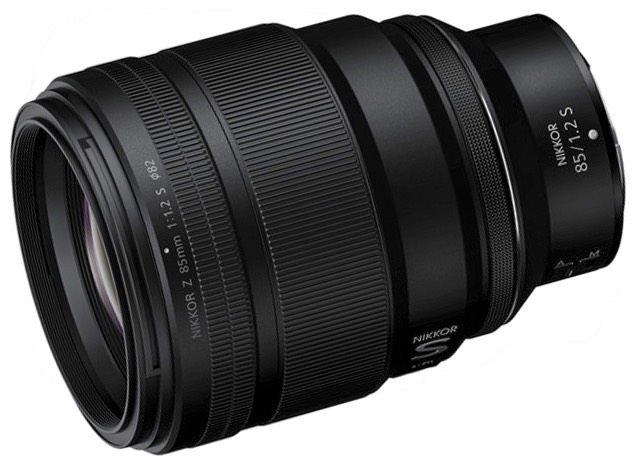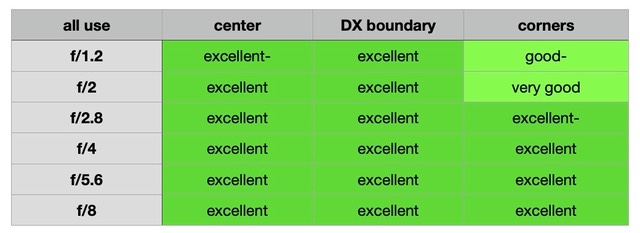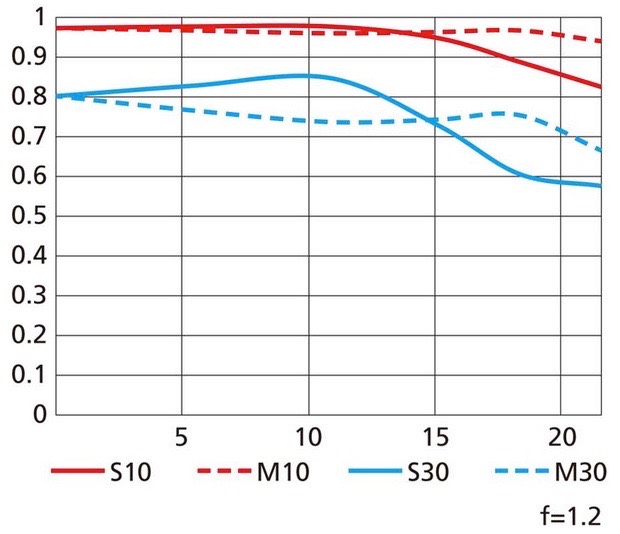
What is It?
The 85mm f/1.2 S is Nikon’s second lens in the “faster prime” series they’ve begun. We never really had a lens like this in the F-mount, so I’m sure there’s curiosity about its appearance in the Z-mount.
The first thing you notice is size. At 5.6” (142mm) long, 4.1” (103mm) in diameter, and weighing in at 40.9 ounces (1160g), you can’t help but notice it. In terms of typical prime focal lengths, the 85mm f/1.2 S is the biggest one so far other than the manual focus NOCT. Two-and-a-half pounds out in front of your camera body is going to be noticed. First by your clients, who hopefully are impressed with size, but quickly enough by you trying to manage a five pound (lens+body) concoction. Consider it weight training.
As you’d expect, optically the f/1.2 S is a bit more complex than the f/1.8 S. Here we have 15 elements in 10 groups (compared to 12 elements in 8 groups). We also get for the first time some aspherical elements (2) in the 85mm prime range from Nikon, along with an ED element. The lens has a Nano coat on at least one internal element, and fluorine coating on the front element for water/dust shedding (but note my comments about flare in the performance section).
Out front, the lens uses 82mm filters, and comes supplied with the HB-106 lens hood. I strongly advise using the hood.
Apertures range from f/1.2 to f/16, the usual stopping point for Nikon primes. An 11-blade aperture diaphragm is as usual in the Z-mount, electronically controlled for speed and precision.
Close focus is 33” (0.85m), which produces a relatively poor 1:9.1 maximum magnification ratio. This is not the lens you take photos of the wedding ring with. That distance, however, is more than enough for portraiture, so don’t panic. Focus itself is done via two stepping motors, and is completely internal within the lens.
In terms of “extras,” like the 135mm f/1.8 S Plena the 85mm f/1.2 S really only has an L-Fn button and an extra programmable control ring. No LED display of information, though now that Nikon is showing distance information in the EXPEED7-driven viewfinders, I don’t think you’ll miss it.
The 85mm f/1.2 S is well sealed for drip and dust resistance, made in <tk>, and sells for US$2800.
Source of the reviewed lens: purchased
How’s it Handle?
The only real handling issue is the diameter bulkiness of the 85mm f/1.2 S. While it’s only 0.2” more in diameter than the 135mm f/1.8 S Plena, for some reason it felt like more to me. Perhaps 4” is my threshold for a prime before it starts to feel a bit too broad. Your hands may vary.
As with the 135mm f/1.8 S Plena, my only real complaint about handling with the 85mm f/1.2 S is the texture on the very front ring of the lens, which is there to help you grip the lens when mounting it on the camera body. Yes, we need a texture—otherwise the polycarbonate outer body of the lens would be too slippery—but that texture needs to be more different than the focus ring texture. That’s particularly true on this lens as the focus ring and grip ring are essentially the same diameter.
How’s it Perform?
Focus: This lens is a bit slower than the 85mm f/1.8 S to focus, though not be a very significant amount. What I find slightly more problematic is that on any over half-second slide-to-focus for the longest close to far focus pulls, I get a fair number of overshoot-and-correct in lower light. In event and portraiture, the focus speed is perfectly fine, but in sports I’d be worried about big composition/focus changes slowing me down some.
Video users will be disappointed to find that there’s a strong focus breathing effect when moving from infinity to close focus, on the order of a 10% increase in subject size. That’s actually better than the 85mm f/1.8 S, but it’s not what the videographers were looking for. For more modest focus distance changes, the breathing is minimal and almost non-detectible, it’s only when you make the long pulls that you’ll see it. For such long focus changes, the 50mm f/1.2 S would be a better choice.

Sharpness: Wide open the center is at what I’d term excellent- (just a bit below what the 50mm f/1.2 S produces). On the other hand, out at the DX boundaries the results are clearly excellent wide open; the DX borders pack a bit more punch in terms of contrast as does the center. The full frame corners drop down, clearly losing contrast and acuity. I’d rate them good- wide open. On the other hand, the 85mm f/1.2 S put up better numbers than the Zeiss Otus 85mm f/1.4 when it came through the studio.
At f/1.8, the 85mm f/1.2 S is better than the 85mm f/1.8 S in all areas except the extreme full frame corners. At f/2.8 I start to see some excellent contrast and acuity in those corners, and the “snap” at f/4 steps that up a bit. This was more clear on the near infinity testing than on the close up testing, but it’s present in both.


Nikon's published theoretical MTF shows some remarkably good contrast behavior wide open.
Coma seems good wide open, and it pretty much disappears by f/2.
Linear Distortion: Somewhere between 1 and 2% pincushion distortion natively, which is as close to perfectly corrected as I’ve seen with the in-camera corrections applied.
Chromatic Aberration: Longitudinal CA is highly present, and you have to stop down quite a ways to minimize it. But that’s pretty normal for really fast primes. While others have reported “little” such CA, I believe they’re wrong. On the other hand, that Longitudinal CA doesn’t seem to produce as bad a high contrast edge as I found on the 50mm f/1.2 S. Still, the magenta forward and purple back tinting is there. Lateral CA is very well corrected, however.
Flare: The only real issue I see with the 85mm f/1.2 S is that with in-frame and edge-frame light sources, It can provoke clear ghosting, and some of that will be prismatic in color. Moreover, light in frame lowers the contrast of what the lens renders (veiling glare, which has to be coming from one of the internal groupings of elements). That was a little surprising to me for a lens that has both Arneo and Nano coating. Something isn’t coated that probably needs to be.
Bokeh: I was a bit disappointed in the bokeh in close examination, but you probably won't be. Clear turtle skinning* with a bright outer ring. The big disappointment was really the cats eye and clipping effects, which start just before the DX boundaries. On the other hand, for out-and-out pleasant blur on normal textures (as opposed to specular highlights), this lens is about as good as I’ve seen in providing that smooth transition from focus to blur in the background. The foreground blur is a little busier. However, note that at f/1.2 your in-focus area is infinitely narrow, so you’re going to get nose and hair blur on tight portraits. You’d better like that blur.
*Yep, a new term. Onion skinning is clear concentric rings in the bokeh ball. Turtle skinning is a term I’ve had to invent: it appears more like the scales of a turtle shell than anything else.
Final Words
I used to use the 105mm f/1.4E for portraits on the DSLRs. The 85mm f/1.2 S certainly is a size substitute for it, and it’s just as mammoth on the front of your camera. However, it’s also a wider, more traditional portrait focal length, which some will prefer.
How you choose one of Nikon’s fast portrait lenses is going to depend upon how you approach perspective in your portraiture. Portraits tend to be done in the 70-135mm range, though there are styles that go outside that. The 85mm f/1.2 S covers more the shorter end, while the 135mm f/1.8 S Plena covers the long end of that range. While I'd judge the Plena to be the "better" lens optically, I don't think you should be choosing a portrait lens on that aspect. Indeed, both the 85mm and 135mm produce such extremely sharp central results, even wide open, that I can see a lot of photographers doing post processing to smooth out skin so that all the pores and blemishes disappear.
The real operative question is whether the 85mm f/1.2 S is worth the price and weight penalty over the excellent 85mm f/1.8 S. I'd say no for most people. The 85mm f/1.2 S does let you push the focal plane tighter and has dreamier out-of-focus areas (other than the potential cats eye). The in-focus to out-of-focus transition is up there with the best rendering Nikon has ever produced, which is saying a lot. From the standpoint of giving you another option in your look vocabulary, the 85mm f/1.2 S definitely does that over the f/1.8 S. Still, you have to consider whether it's worth the extra money and weight.
I'd also point out that the 85mm f/1.2 S mates up best with the Z9. Big body, big lens; the handling is excellent as you'd expect, but it's a heavy burden to carry all day. At the other extreme, this lens makes for a front-heavy combination on the Z6/Z7 and Zf bodies, and on the Zf body, in particular, I hope you've added a hand grip. I mostly used the lens on the Z8 for this review, and found that combination okay, though a bit bulky out front of the camera.
I was a bit surprised at how much I liked this lens in use, though. I'm generally not a portrait photographer, but I do end up doing some work that's similar in the sports realm, where this lens ends up being a dreamy addition to my kit. I wish I had the 85mm f/1.2 S back when I was doing more team portrait and player isolation work up close, it just renders so beautifully when used correctly. If you’re doing portraits and find the f/1.8 lenses restrictive, this is one of the lenses you should be looking at.
Recommended (2023 to present) why not Highly Recommended? Mainly because of the cost and weight coupled with overall usefulness; you really need to need this lens
Support this site by purchasing from the following advertiser:
